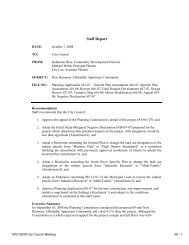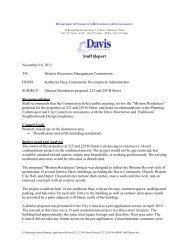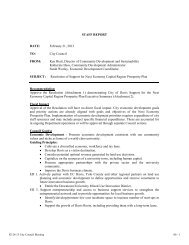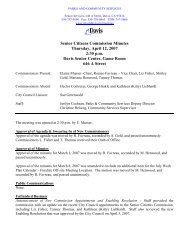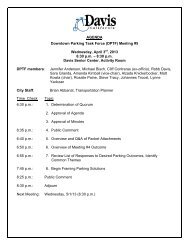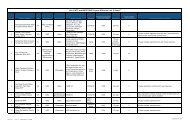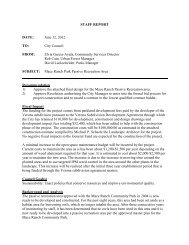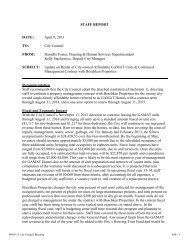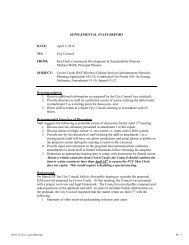10 Draft Integrated Waste Management Plan - City Council - City of ...
10 Draft Integrated Waste Management Plan - City Council - City of ...
10 Draft Integrated Waste Management Plan - City Council - City of ...
You also want an ePaper? Increase the reach of your titles
YUMPU automatically turns print PDFs into web optimized ePapers that Google loves.
2012 Davis <strong>Integrated</strong> <strong>Waste</strong> <strong>Management</strong> <strong>Plan</strong><br />
As Figure M-1 and Table M-1 show, removing the food scraps from the commercial and residential trash is<br />
estimated to achieve a 51.8% diversion, based solely on services provided by DWR. This does not include data<br />
from self-haul loads going to the landfill, recycling centers and composting facilities, nor does it take into<br />
account waste reduction and reuse options. CalRecycle’s per capital disposal rate data takes these other<br />
measures into account, as they calculate based on tonnage <strong>of</strong> trash sent to the landfill. This tonnage will go<br />
down as a result <strong>of</strong> waste reduction, reuse, recycling, composting and all diversion methods—those that are<br />
captured in DWR’s numbers and those that are not.<br />
Another way to estimate the potential food scrap diversion is to look at the data from the Commercial Food<br />
Scrap Pilot Program. Figure M-2 and Table M-2 below use data gathered from the pilot to estimate the<br />
potential <strong>of</strong> food scrap recovery. There has been a gradual increase in the number <strong>of</strong> participants in the<br />
Commercial Food Scrap Pilot Program, so to accurately portray the collection <strong>of</strong> food scraps, it is better to use a<br />
smaller scale <strong>of</strong> data. Instead <strong>of</strong> using a year’s worth <strong>of</strong> data reports, a single quarter (3 rd quarter 2012) is used<br />
for this comparison. In October 2012, there were 26 participants signed up for the food scrap program. These<br />
26 businesses collected a total <strong>of</strong> 58.66 tons <strong>of</strong> food scraps from July 2012-September 2012 (approximately 2.3<br />
tons <strong>of</strong> food scraps per business). There are approximately 181 large food scrap generating businesses in town<br />
(restaurants, schools, hospitals, etc.). If each <strong>of</strong> these businesses also generated 2.26 tons <strong>of</strong> food scraps during a<br />
single quarter, there could be another 349.68 tons <strong>of</strong> food scraps potential recoverable. This potential recovery<br />
is shown in the chart and table below. Residential food scrap numbers shown are estimated as 25.4% <strong>of</strong> the<br />
residential waste stream, as reported by CIWMB’s 2008 Statewide <strong>Waste</strong> Characterization Study.<br />
FIGURE M-2 JULY – SEPTEMBER 2012 DWR COLLECTION DATA WITH POTENTIAL FOOD SCRAP RECOVERY<br />
Commercial<br />
Garbage 23.0%<br />
Roll-Off Boxes<br />
15.8%<br />
Recycling 15.0%<br />
DRAFT<br />
Residential<br />
Garbage 14.7%<br />
Inerts 4.1%<br />
Yard Materials<br />
18.2%<br />
Commercial<br />
Food Scraps<br />
Collected 0.5%<br />
Remaining<br />
Commercial<br />
Food Scraps<br />
3.0%<br />
Residential Food<br />
Scraps 5.0%<br />
C&D 0.9%<br />
Page | M-193



